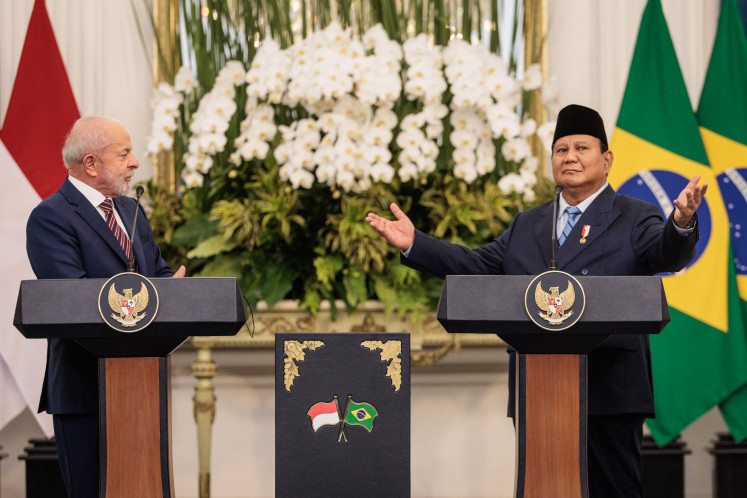Popular Reads
Top Results
Can't find what you're looking for?
View all search resultsPopular Reads
Top Results
Can't find what you're looking for?
View all search resultsReforming fiscal base: The road to a 15% tax ratio
Indonesia can learn from the experiences of its regional peers in coming up with a localized strategy to achieve its targeted tax ratio of 15 percent by 2029.
Change text size
Gift Premium Articles
to Anyone
T
he government’s 2025-2029 National Medium-Term Development Plan (RPJMN) has set a target to increase the tax-to-GDP ratio (tax ratio) to around 15 percent, which reflects the need to strengthen fiscal space for financing infrastructure, education, health and other strategic programs while simultaneously reducing dependence on debt financing. A higher tax ratio is expected to support fiscal stability and reinforce the country’s economic resilience.
Over the past two decades, Indonesia’s tax ratio has shown a persistent downward trend. Since peaking at 13.3 percent in 2008, it has steadily declined to 10.1 percent in 2024, only 1.8 percentage points above its lowest level during the COVID-19 pandemic, when it fell to 8.3 percent.
This decline stems from a combination of structural factors, such as a narrow tax base, low compliance and limited fiscal policy effectiveness, rather than mere cyclical factors.
More than half the workforce (59 percent) is employed in the informal sector, leaving the potential for personal income tax and domestic value-added tax (VAT) largely untapped. In addition, tax revenues remain heavily dependent on commodities and corporate income tax, making the overall ratio vulnerable to commodity price fluctuations.
Fiscal incentives such as tax holidays and tax allowances have contributed to short-term declines in tax revenue by lowering the effective tax rate for large corporations operating in special economic zones (SEZs). However, the deeper issue lies in the fact that the economic expansion generated by these fiscal incentives has not been accompanied by a proportional increase in the tax base, indicating that structural weaknesses remain the primary cause of Indonesia’s stagnant tax ratio.
Indonesia has continued to lag behind its regional peers. Several countries in Southeast Asia have either achieved or surpassed a tax ratio of 15 percent. For instance, the tax ratio in Thailand reached approximately 15.5 percent in 2013, though it later declined to 13.2 percent in 2024.
The Philippines’ tax ratio grew from 11.2 percent in 2004 to 14.4 percent in 2024. This improvement was driven by reforms that broadened the tax base, including VAT expansion, digitalized tax administration and enhanced compliance by reducing leakages. Malaysia meanwhile expanded its digital services tax and introduced a national e-invoicing system.
The collective experience of these countries demonstrates that the most effective approach is not simply raising rates, but also expanding the tax base and strengthening administration.
Broadening the tax base in the next four years has become crucial amid calls to lower tax rates. Reducing rates may improve investment competitiveness and maintain domestic consumption, yet without a broader base, fiscal capacity will weaken. A wider tax base, achieved through improved compliance, digitalized tax administration, interagency data integration and economic formalization, represents a more realistic and sustainable strategy than merely raising rates or relying on additional fiscal incentives.
Nevertheless, broadening Indonesia’s tax base faces substantial challenges. The high level of informality limits economic documentation, weakens compliance and restricts contributions from personal income tax and VAT.
Moreover, the labor market remains fragmented with around 25.8 percent of workers employed part-time, implying underutilized labor and lower productivity. This structure hinders the transition toward a formal economy and constrains tax base expansion. Without a significant structural shift and a decline in informality, prospects for improving the tax ratio will remain limited.
Expanding the tax base also requires concrete steps to formalize the micro, small and medium enterprise (MSME) sector that dominates the national economy. MSMEs contribute roughly 60 percent of GDP and employ over 97 percent of the workforce, yet only a small fraction are registered, active taxpayers.
The final rate of 0.5 percent for MSMEs, which has been extended through 2029, can serve as a bridge toward formalization while building tax compliance histories. As the number of active taxpayers increases, the tax base will widen and revenues will strengthen.
On the corporate side, the implementation of the 15 percent global minimum tax for multinational enterprises is an important instrument for strengthening revenue bases. This policy ensures that Indonesia secures a fair share of taxes from global corporate activities and helps prevent profit shifting among multinationals to low-tax jurisdictions.
Furthermore, tax rate policies should be formulated selectively and based on sound economic analysis. The government has introduced an excise tax on sugar-sweetened beverages that has higher revenue elasticity and manageable social impacts. In addition, developing environmental tax instruments, such as a carbon tax, could generate new revenue streams while supporting the green transition agenda.
Despite these promising strategies, several risks and challenges must be anticipated.
First are macroeconomic risks: The global economic slowdown and falling commodity prices could erode the economic base underpinning corporate and consumption taxes. Second are sociopolitical risks: Poorly communicated tax increases could provoke public resistance, weakening voluntary compliance. Third are structural risks: Without labor market formalization and improved tax literacy, efforts to expand the tax base will progress slowly.
In conclusion, achieving a 15 percent tax ratio within the next four years is not merely a quantitative target but a comprehensive reform process requiring administrative integration, digital transformation and economic formalization. The experiences of regional peers show that successful tax reform depends on a broad base, well-calibrated rates and consistent compliance.
For Indonesia, the reform momentum that began in 2025 can lay the foundation for a more independent and sustainable fiscal system, provided it is executed with discipline, data-driven policymaking and a balanced consideration of growth and social equity.
*****
The writer is an economist at Bank Mandiri.











